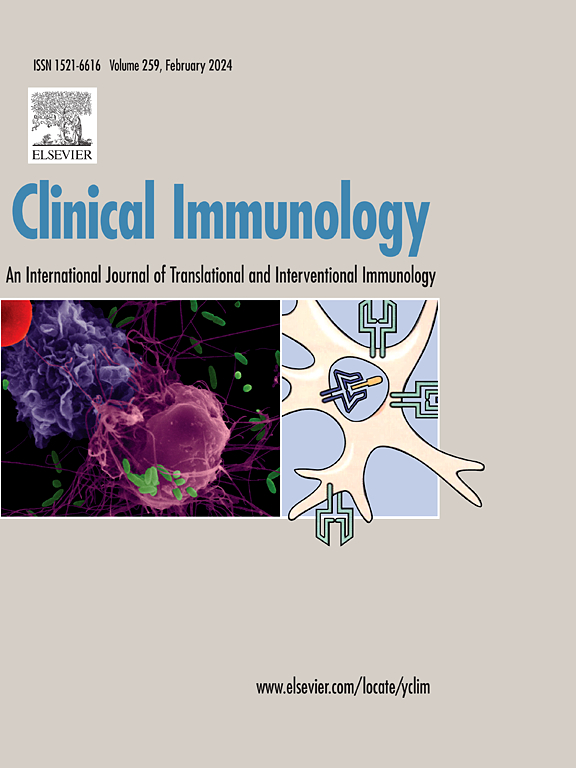一项关于40年遗传性血管性水肿预防的全国调查:新旧药物的有效性和安全性。
IF 3.8
3区 医学
Q2 IMMUNOLOGY
引用次数: 0
摘要
背景:遗传性血管性水肿(HAE)由于发作的不可预测性给患者带来了沉重的负担。长期预防(LTP)旨在预防这些发作并改善生活质量。在过去的50年里,LTP的选择已经从非特异性治疗(新鲜冷冻血浆、减毒雄激素、抗纤溶药物)发展到更有针对性的治疗(静脉或皮下C1抑制剂(C1INH)、lanadelumab、贝曲司他)。目的:评估各种LTP治疗在匈牙利HAE患者中的使用、疗效和安全性。方法:分析匈牙利HAE登记处(1979-2023)的数据,包括LTP的使用、发病率、副作用和实验室参数。结果:达那唑和氨甲环酸的使用在前30 年有所增加,但在最近十年有所下降。相反,在过去十年中,现代LTP疗法的使用和完全依赖按需用药的患者比例显著增加。在最低有效剂量下,达那唑和氨甲环酸降低了60% %患者的发病率,而实验室参数没有显著变化。此外,与治疗前相比,100 %的皮下注射C1INH、lanadelumab和贝曲司他的患者发作次数更少,生活质量得到改善,没有严重的副作用或显著的实验室异常。结论:匈牙利HAE-C1INH患者的现代预防使用正在增加,与全球趋势一致。在适当的监测下,现代和传统的LTP方案在我们的患者群体中被证明是安全有效的。本文章由计算机程序翻译,如有差异,请以英文原文为准。
A national survey of four decades of hereditary angioedema prophylaxis: Efficacy and safety of old and new drugs
Background
Hereditary angioedema (HAE) imposes a significant burden on patients due to the unpredictability of attacks. Long-term prophylaxis (LTP) aims to prevent these episodes and improve quality of life. Over the past five decades, LTP options have evolved from non-specific treatments (fresh frozen plasma, attenuated androgens, antifibrinolytics) to more targeted therapies (intravenous or subcutaneous C1 inhibitor (C1INH), lanadelumab, berotralstat).
Objective
To assess the use, efficacy, and safety of various LTP therapies among Hungarian HAE patients.
Methods
Data from the Hungarian HAE Registry (1979–2023) were analysed, including LTP usage, attack rates, side effects, and laboratory parameters.
Results
Danazol and tranexamic acid use increased over the first 30 years but has declined in the last decade. Conversely, the use of modern LTP therapies and the proportion of patients relying solely on on-demand medication have significantly increased over the past decade. Danazol and tranexamic acid reduced attack rates in 60 % of patients without significant changes in the laboratory parameters at the lowest effective doses. Furthermore, 100 % of patients on subcutaneous C1INH, lanadelumab, and berotralstat experienced fewer attacks and improved quality of life compared to pre-treatment periods, with no serious side effects or significant laboratory abnormalities.
Conclusion
Modern prophylaxis usage is increasing among Hungarian HAE-C1INH patients, following the global trends. Both modern and traditional LTP options proved safe and effective in our patient population when used with appropriate monitoring.
求助全文
通过发布文献求助,成功后即可免费获取论文全文。
去求助
来源期刊

Clinical immunology
医学-免疫学
CiteScore
12.30
自引率
1.20%
发文量
212
审稿时长
34 days
期刊介绍:
Clinical Immunology publishes original research delving into the molecular and cellular foundations of immunological diseases. Additionally, the journal includes reviews covering timely subjects in basic immunology, along with case reports and letters to the editor.
 求助内容:
求助内容: 应助结果提醒方式:
应助结果提醒方式:


